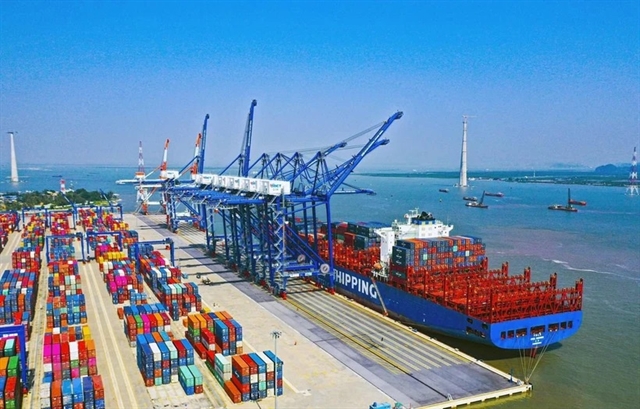
|
| A container ship during loading at the Lạch Huyện Port in the northern city of Hải Phòng. VNA/VNS Photo |
HÀ NỘI Ongoing tension in the Red Sea has hiked freight rates and increased the possibility of delays, warned the Ministry of Industry and Trade.
In the latest statement released by the ministry, MoIT urged Vietnamese exporters and industries to closely watch the situation in the Red Sea, prepare contingency plans for import-export activities, keep close contact with foreign partners and diversify sources to protect the supply chain. Exploring alternative transportation methods, such as rail transport, was also recommended.
In addition, the ministry advised exporters to include compensation clauses and exemption of responsibility in emergencies. Meanwhile, insurance policies should be obtained to minimise financial risks. Businesses were asked to promptly contact the MoIT if they required assistance.
To date, more than 170 ships have been redirected south towards Africa since December 20, with approximately 35 ships delayed in the Red Sea, according to the digital freight forwarding company Flexport. The rerouting is expected to extend shipping time by 10 to 14 days, resulting in a significant increase in fuel and crew costs.
In light of these developments, businesses engaged in export and import should anticipate risks. The tension in the Red Sea could lead to additional costs of US$1,000 to $2,000 for a container passing through to Europe. Industries such as textiles, footwear and furniture may be significantly affected.
According to the Maritime and Logistics market news from the Vietnam Ship Agents and Brokers Association (Visaba), container ship operators are trying to cut additional costs by avoiding sailing around Africa and facing substantial or novel additional fees. The Mediterranean Shipping Company (MSC) plans to increase the shipping cost of one container from Europe to Asia with an unprecedented surcharge. Similarly, shipping company CMA CGM is considering charging $2,700 per container to cover the costs of loading or unloading at ports in the Red Sea.
Even before the Red Sea crisis, shipping companies had planned to raise freight rates or even double them in some cases before the Lunar New Year in February. These shipments are now facing peak season surcharges (PSS) and war risk surcharges. It is anticipated that these fees will continue to rise as the number of delayed or rerouted ships continues to increase.
Recent incidents of attacks on cargo ships in the Gulf of Aden and the Red Sea have led some shipping companies to announce the suspension of cargo transportation through the Red Sea, rerouting around the Horn of Africa.
These disruptions are having negative effects on international trade, causing delays in maritime shipments between Asia and Europe and the North East Coast of North America. Freight charges and insurance fees for cargo exchanged between these regions are increasing. Shortages of empty containers may also occur locally.
The Suez Canal connects the Red Sea to the Mediterranean and serves as the fastest route for transporting fuel, food and consumer goods from Asia and the Middle East to Europe. This route is crucial for transporting about one-third of the global cargo, including toys, tennis shoes, furniture and frozen food. VNS
- Reduce Hair Loss with PURA D’OR Gold Label Shampoo
- Castor Oil Has Made a “Huge” Difference With Hair and Brow Growth
- Excessive hair loss in men: Signs of illness that cannot be subjective
- Dịch Vụ SEO Website ở Los Angeles, CA: đưa trang web doanh nghiệp bạn lên top Google
- Nails Salon Sierra Madre
 VnExpress News The News Gateway of Vietnam
VnExpress News The News Gateway of Vietnam




